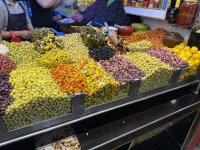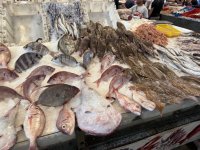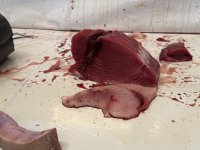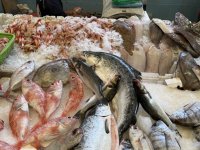You are using an out of date browser. It may not display this or other websites correctly.
You should upgrade or use an alternative browser.
You should upgrade or use an alternative browser.
Where to, captain?
- Thread starter Brett-EDH
- Start date
Darryl - swazies
TVWBB Platinum Member
Another set of great photos.
This is a heck of a trip....if I don't get home from holidays in 7 days or less I am not sure what would happen......
Sounds like a once in a life time trip....get it all in while you are there I guess.............
This is a heck of a trip....if I don't get home from holidays in 7 days or less I am not sure what would happen......
Sounds like a once in a life time trip....get it all in while you are there I guess.............
Brett-EDH
TVWBB Olympian
we joke that we want to travel when we don’t need walkers or have to bring air in a can. So while we’re able bodied and can walk these steps, hills and super uneven roads. I’m telling you, my feet were in pain every evening from the cobblestones and uneven pavement. And I bought nice running shoes for this trip with major cushioning.Another set of great photos.
This is a heck of a trip....if I don't get home from holidays in 7 days or less I am not sure what would happen......
Sounds like a once in a life time trip....get it all in while you are there I guess.............
You’ll probably laugh when this is all done. We’ve got a ways to go here. Hang on for the ride.
Last edited:
Brett-EDH
TVWBB Olympian
Porto’s old town has very steep streets. It’d be tough to walk up with provisions and groceries. I’m not sure how the old city inhabitants did it.
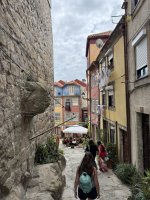
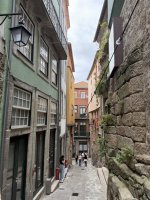
Portugal and Spain were both very unkind to their Jewish populations. Unkind is an understatement here.
Portugal forced Jews to convert to Christianity and those who did were called New Christians, or Conversos. Those who secretly practiced Judaism were Crypto-Jews.
Portugal labeled each house of the Conversos by forcing them to mark their homes with a cross, usually forming a “T” where the Jewish Mezuzah was placed outside the home.
You can see many of these crosses at homes in the old quarters.

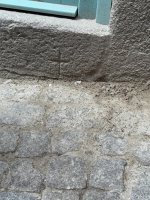
Climbing the stairs to where one of the synagogues used to be. All the Jewish cultural buildings were converted or destroyed by the Portuguese.
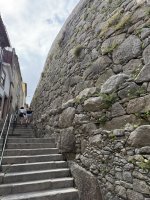
A random plaque placed in no specific area of the old Jewish quarter as Portugal is today, rewriting its history to “clean” it up to a more acceptable public level. I’ll avoid further public comment on this subject.
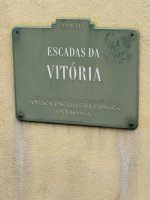
The church now occupies the land of the former synagogue. Note the simple language of the public marker.
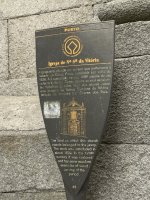
A street marker denoting the old Jewish quarter.
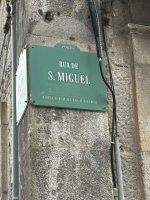
The history in Porto is fascinating. Although physically, nothing remains of the Jewish community that thrived there for hundreds of years, the city understands its actions were humanly abhorrent.
On our way back to the cruise ship, the ship terminal building is art on its own.
There’s a very active and rich fishing history here. And some of the foods of Portugal are delicious. Think anchovies and sardines. Some of the better in the world. Personally, we liked the fish of the Mediterranean better than the North Atlantic. We’ll talk about that more later.
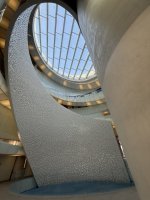
Our ship in port (in Porto). Had to say that
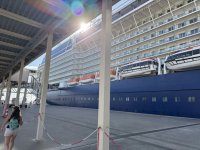
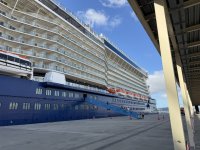
Next port? Lisbon!


Portugal and Spain were both very unkind to their Jewish populations. Unkind is an understatement here.
Portugal forced Jews to convert to Christianity and those who did were called New Christians, or Conversos. Those who secretly practiced Judaism were Crypto-Jews.
Portugal labeled each house of the Conversos by forcing them to mark their homes with a cross, usually forming a “T” where the Jewish Mezuzah was placed outside the home.
You can see many of these crosses at homes in the old quarters.


Climbing the stairs to where one of the synagogues used to be. All the Jewish cultural buildings were converted or destroyed by the Portuguese.

A random plaque placed in no specific area of the old Jewish quarter as Portugal is today, rewriting its history to “clean” it up to a more acceptable public level. I’ll avoid further public comment on this subject.

The church now occupies the land of the former synagogue. Note the simple language of the public marker.

A street marker denoting the old Jewish quarter.

The history in Porto is fascinating. Although physically, nothing remains of the Jewish community that thrived there for hundreds of years, the city understands its actions were humanly abhorrent.
On our way back to the cruise ship, the ship terminal building is art on its own.
There’s a very active and rich fishing history here. And some of the foods of Portugal are delicious. Think anchovies and sardines. Some of the better in the world. Personally, we liked the fish of the Mediterranean better than the North Atlantic. We’ll talk about that more later.

Our ship in port (in Porto). Had to say that


Next port? Lisbon!
Last edited:
Timothy F. Lewis
TVWBB 1-Star Olympian
Great travelogue Brett! I wish I could be along for the ride! Sounds like you’re having a good time!
Brett-EDH
TVWBB Olympian
Lisbon, Portugal. We weren’t really prepared for what we’d learn on our tour.
Lisbon is a rapidly changing city. From what was a very poor and dilapidated and crumbling city, a renaissance is underway. That’s not all good.
Many locals can no longer afford to live in their own city center and foreign money has bought up a lot of the real estate.
On this block you can now find a few Michelin restaurants, Scarlet Johansson bought a building and Chef Jamie Oliver has opened a new restaurant. That gives you a hint at the money that’s flowed in over the past 8 years and only accelerated post pandemic.
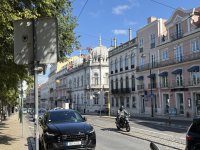
The former Rothschild family bank which was a private lender/banking of the old Jewish community when Jews couldn’t bank in traditional banks.
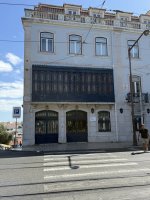
Note, St. George’s castle in the distance, atop the highest point in Lisbon.

Note the white, multistory building in the dead center of this photo.
This is the location where 40,000 Jewish men were rounded up into a stockade for mass conversions, against the will of those men. Those who refused to convert were quartered for all the others to watch.
Here’s what Google says as it makes my posting a little easier than writing it all myself:
“
More from the Google:
“Lisbon's Jewish community faced forced conversions to Christianity in the late 15th century, leading to the creation of "New Christians" (Conversos) who secretly continued Jewish practices, and a tragic massacre in 1506
. While the city's Jewish quarter's physical remnants were largely erased by subsequent urban development and the 1755 earthquake, Lisbon now actively works to enhance its Jewish heritage through tours and memorials.“
The last sentence above is a massive stretch. Lisbon has a long way to go to own its past and to honor all those it slaughtered. Yes, changes have been made and are being made. But have you ever seen how long it takes to get molasses out of a jar? It’s really not that fast.
From our walking tour, we made our way through the three prior Jewish quarters. As the Jewish population grew over time, the Jewish community relocated to better serve the needs of its members.
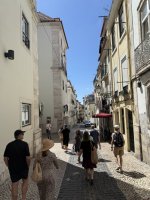

The Carmo Convent Lisbon was a majestic Gothic church in Lisbon until it was destroyed by the earthquake of 1755.
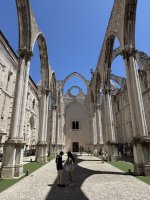
It serves as a museum of Lisbon’s history and has an area dedicated to the few Jewish ruins that have been recovered today.
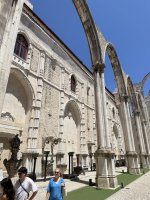
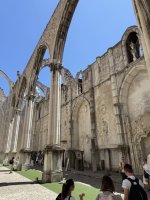
Portugal on gained it’s democratic freedom on April 25, 1974, just 51 years ago.
Google:
“The "Lisbon Uprising" primarily refers to the
Carnation Revolutionof April 25, 1974, a nearly bloodless military coup that overthrew the Estado Novo dictatorship in Portugal and led to the end of its colonial wars and the establishment of the Third Republic. While the Carnation Revolution is the most prominent event, an earlier "Castle Uprising" occurred in Lisbon in 1928, a military and civilian revolt against the Military Dictatorship that was ultimately suppressed.“
Here’s an enlarged picture of that day in Lisbon:
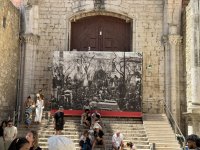
The Carmo Convent has a small Jewish artifacts museum. Here’s a few pics of what’s been salvaged and discovered today:
A gravestone
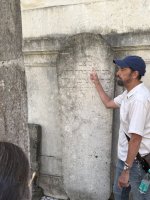
A crypt of the former Lisbon Rabbi (also a doctor and teacher) as many learned people had many roles. The Rabbi was buried in this grand crypt as he helped treat and heal the King of Portugal. I guess that’s one way to get a good send off.
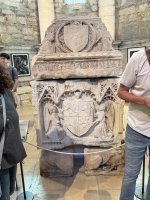
Carving on this crypt showing the Rabbi was also a doctor.
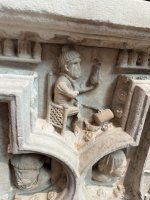
Another headstone. All this inscription is hand chiseled. Incredible to just think about it.
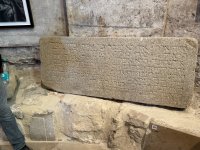
Hidden below the city at the mouth of the Tagus River, once stood a Jewish synagogue. It collapsed during an earthquake and subsequent tsunami that burried the low land of Lisbon.
It’s basically where the bay meets the land in this pic.
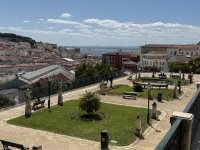
A Church now sits atop those buried ruins which are perfectly preserved around 10 meters below the current grade. There are hopeful plans in the works to unearth that synagogue and add the remains to a Lisbon Jewish history museum. Until that museum space is acquired and built, the goal is the keep the old synagogue burried as it’s the best way to preserve it until it can be preserved once unearthed.
Lisbon is a rapidly changing city. From what was a very poor and dilapidated and crumbling city, a renaissance is underway. That’s not all good.
Many locals can no longer afford to live in their own city center and foreign money has bought up a lot of the real estate.
On this block you can now find a few Michelin restaurants, Scarlet Johansson bought a building and Chef Jamie Oliver has opened a new restaurant. That gives you a hint at the money that’s flowed in over the past 8 years and only accelerated post pandemic.

The former Rothschild family bank which was a private lender/banking of the old Jewish community when Jews couldn’t bank in traditional banks.

Note, St. George’s castle in the distance, atop the highest point in Lisbon.

Note the white, multistory building in the dead center of this photo.
This is the location where 40,000 Jewish men were rounded up into a stockade for mass conversions, against the will of those men. Those who refused to convert were quartered for all the others to watch.
Here’s what Google says as it makes my posting a little easier than writing it all myself:
“
- Forced Conversion and "New Christians": In 1496-97, King Manuel I, under pressure to marry into the Spanish royal family and influenced by the Spanish Inquisition, decreed that Jews in Portugal must convert to Catholicism or face expulsion. Many Jews were forcibly baptized, becoming "New Christians," who, despite outwardly practicing Catholicism, often secretly maintained their Jewish faith.”
More from the Google:
“Lisbon's Jewish community faced forced conversions to Christianity in the late 15th century, leading to the creation of "New Christians" (Conversos) who secretly continued Jewish practices, and a tragic massacre in 1506
. While the city's Jewish quarter's physical remnants were largely erased by subsequent urban development and the 1755 earthquake, Lisbon now actively works to enhance its Jewish heritage through tours and memorials.“
The last sentence above is a massive stretch. Lisbon has a long way to go to own its past and to honor all those it slaughtered. Yes, changes have been made and are being made. But have you ever seen how long it takes to get molasses out of a jar? It’s really not that fast.
From our walking tour, we made our way through the three prior Jewish quarters. As the Jewish population grew over time, the Jewish community relocated to better serve the needs of its members.


The Carmo Convent Lisbon was a majestic Gothic church in Lisbon until it was destroyed by the earthquake of 1755.

It serves as a museum of Lisbon’s history and has an area dedicated to the few Jewish ruins that have been recovered today.


Portugal on gained it’s democratic freedom on April 25, 1974, just 51 years ago.
Google:
“The "Lisbon Uprising" primarily refers to the
Carnation Revolutionof April 25, 1974, a nearly bloodless military coup that overthrew the Estado Novo dictatorship in Portugal and led to the end of its colonial wars and the establishment of the Third Republic. While the Carnation Revolution is the most prominent event, an earlier "Castle Uprising" occurred in Lisbon in 1928, a military and civilian revolt against the Military Dictatorship that was ultimately suppressed.“
Here’s an enlarged picture of that day in Lisbon:

The Carmo Convent has a small Jewish artifacts museum. Here’s a few pics of what’s been salvaged and discovered today:
A gravestone

A crypt of the former Lisbon Rabbi (also a doctor and teacher) as many learned people had many roles. The Rabbi was buried in this grand crypt as he helped treat and heal the King of Portugal. I guess that’s one way to get a good send off.

Carving on this crypt showing the Rabbi was also a doctor.

Another headstone. All this inscription is hand chiseled. Incredible to just think about it.

Hidden below the city at the mouth of the Tagus River, once stood a Jewish synagogue. It collapsed during an earthquake and subsequent tsunami that burried the low land of Lisbon.
It’s basically where the bay meets the land in this pic.

A Church now sits atop those buried ruins which are perfectly preserved around 10 meters below the current grade. There are hopeful plans in the works to unearth that synagogue and add the remains to a Lisbon Jewish history museum. Until that museum space is acquired and built, the goal is the keep the old synagogue burried as it’s the best way to preserve it until it can be preserved once unearthed.
Brett-EDH
TVWBB Olympian
The 1506 Masacre
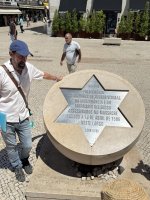
It is believed that over 4,000 New Christians (Jews) were killed in one day.
This explanation is a tad bit whitewashed but I don’t need to go further. You can learn more on your own. This isn’t a political post. It’s what I did on my summer vacation when your grade school teacher asks you to write your essay
“On the evening of 19 April, Dominican friars instigated the population to kill the new Christians. Between 2,000 and 4,000 people have died in a barbaric form, incinerated in piles in various parts of the city.”
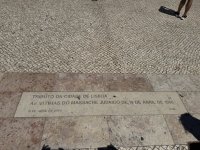
The actual church is on the right in this photo.

Lisbon was an amazing place to visit. I should have paid better attention in school and history to know more of what happened there.
Europe has been one crazy experience so far. Her history is so rich and so troubling, all at once.
Next stop? I’ll let you guess a bit before the next chapter comes.
Hopefully you’re enjoying this as much as we did. Travel is one of the greatest things we can do as people. Learn about other people, cultures and their foods. I think it helps bring peace to a very chaotic world.

It is believed that over 4,000 New Christians (Jews) were killed in one day.
This explanation is a tad bit whitewashed but I don’t need to go further. You can learn more on your own. This isn’t a political post. It’s what I did on my summer vacation when your grade school teacher asks you to write your essay
“On the evening of 19 April, Dominican friars instigated the population to kill the new Christians. Between 2,000 and 4,000 people have died in a barbaric form, incinerated in piles in various parts of the city.”

The actual church is on the right in this photo.

Lisbon was an amazing place to visit. I should have paid better attention in school and history to know more of what happened there.
Europe has been one crazy experience so far. Her history is so rich and so troubling, all at once.
Next stop? I’ll let you guess a bit before the next chapter comes.
Hopefully you’re enjoying this as much as we did. Travel is one of the greatest things we can do as people. Learn about other people, cultures and their foods. I think it helps bring peace to a very chaotic world.
Last edited:
Brett-EDH
TVWBB Olympian
Thank you. We’ve had a great time on this journey. So much culture and history. Our view of things has definitely changed. We’re both (wife and I) grateful to be able to partake in this travel. We feel very fortunate, considering all the world events happening in real time around us.Great travelogue Brett! I wish I could be along for the ride! Sounds like you’re having a good time!
Brett-EDH
TVWBB Olympian
We made it. First time on the African continent.
We are going to tour Tangier, Morocco!
We did a semi-private tour which turned out to be private. Just my wife and I. And boy, we’re in in for putting on the driving and feet miles.
First view of the Atlantic from a vista in Tangier.
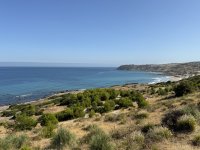
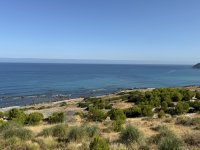
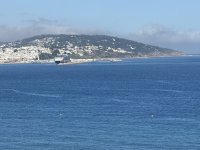
And the city itself.

Then we drive up a hill to where the most luxurious homes are in Tangier. This is a view towards the Mediterranean Sea. Basically we’re in the Strait of Gibraltar.

Then on our drive, we pass this place.
While it looks like the gates at Paramount in LA, it is a home of the royal Saudi family.
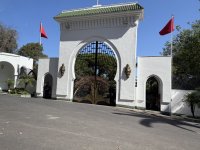

 maps.apple.com
maps.apple.com
The place was ringed with armed and dressed guards.

Further along the hill was a public natural preserve. This land used to be owned by a US diplomat’s family and they had no children. After the wife’s passing the entire land was donated to the city to be a nature preserve and open space. The views from this land were pretty spectacular.
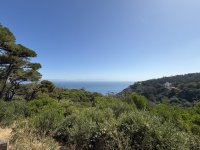
This was the family’s house.

The views are breathtaking.
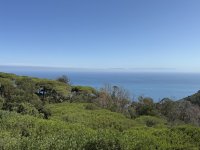
Then we headed towards the lighthouse. Cape Spartel lighthouse nonetheless. Its location marks the point of the Mediterranean Sea meeting the Atlantic Ocean.
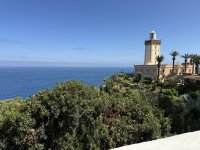

 en.m.wikipedia.org
en.m.wikipedia.org
Then we drive to the beach area and found some camels.

Then we headed over to the old walled city. The Kasbah. I’ve never turned or experienced anything like it.
The old city was protected with canons as it served as a fort to protect her inhabitants. The inside is absolutely crazy and fascinating.

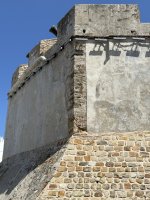
Originally partially built in the Phoenician times the current structure was mostly modified in the 17th century.
“The Kasbah's location, perched on the highest point of Tangier, has made it a strategic site for various rulers throughout history, including the Phoenicians, Romans, Vandals, Byzantines, Arabs, Portuguese, and English.“ - (Google search results to help me speed my postings)
We are going to tour Tangier, Morocco!
We did a semi-private tour which turned out to be private. Just my wife and I. And boy, we’re in in for putting on the driving and feet miles.
First view of the Atlantic from a vista in Tangier.



And the city itself.

Then we drive up a hill to where the most luxurious homes are in Tangier. This is a view towards the Mediterranean Sea. Basically we’re in the Strait of Gibraltar.

Then on our drive, we pass this place.
While it looks like the gates at Paramount in LA, it is a home of the royal Saudi family.

Tangier
View details about Tangier in Tangier, Morocco on Apple Maps. Address, driving directions, images, nearby attractions and more.
The place was ringed with armed and dressed guards.

Further along the hill was a public natural preserve. This land used to be owned by a US diplomat’s family and they had no children. After the wife’s passing the entire land was donated to the city to be a nature preserve and open space. The views from this land were pretty spectacular.

This was the family’s house.

The views are breathtaking.

Then we headed towards the lighthouse. Cape Spartel lighthouse nonetheless. Its location marks the point of the Mediterranean Sea meeting the Atlantic Ocean.


Cape Spartel - Wikipedia
Then we drive to the beach area and found some camels.

Then we headed over to the old walled city. The Kasbah. I’ve never turned or experienced anything like it.
The old city was protected with canons as it served as a fort to protect her inhabitants. The inside is absolutely crazy and fascinating.


Originally partially built in the Phoenician times the current structure was mostly modified in the 17th century.
“The Kasbah's location, perched on the highest point of Tangier, has made it a strategic site for various rulers throughout history, including the Phoenicians, Romans, Vandals, Byzantines, Arabs, Portuguese, and English.“ - (Google search results to help me speed my postings)
Brett-EDH
TVWBB Olympian
The Kasbah entrance from its highest point.


Map of the Kasbah if you’re thinking of running some covert op there.

Some pretty old trees exist inside the walled city.

Some of the paths are single person and two person wide. Others are more open and modern. This being the older part, you can see how narrow the streets are and the winding paths are part of its protection. To confuse anyone who enters but doesn’t live there.
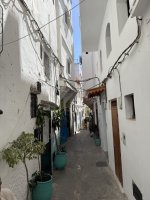
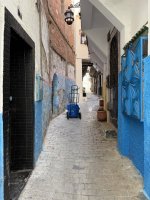
The doors are made from wood and are quite ornate. Replaced doors are often periodical replicas.
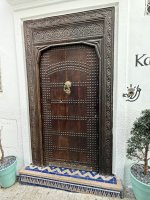

One of the more beautiful streets.
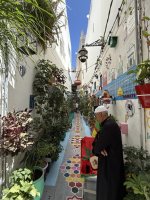







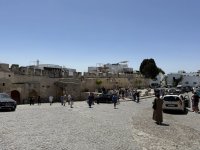
Bab al Bahar gate

The view to the Mediterranean Sea once inside.

The former jail is now a museum of the Kasbah.



Map of the Kasbah if you’re thinking of running some covert op there.

Some pretty old trees exist inside the walled city.

Some of the paths are single person and two person wide. Others are more open and modern. This being the older part, you can see how narrow the streets are and the winding paths are part of its protection. To confuse anyone who enters but doesn’t live there.


The doors are made from wood and are quite ornate. Replaced doors are often periodical replicas.


One of the more beautiful streets.








mindtrip
mindtrip.ai

Bab al Bahar gate

The view to the Mediterranean Sea once inside.

The former jail is now a museum of the Kasbah.

Last edited:
Brett-EDH
TVWBB Olympian
This used to be a public fountain. The artwork is truly amazing.

This scene was part of the Bond movie, Spectre. We had lunch at the restaurant (rooftop) right where the steps in Tangiers is in this scene.

The first 36 seconds is this court area off to the left. The background of that shot of the sea are the following pics.
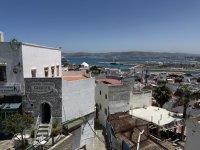

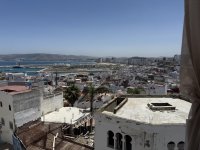
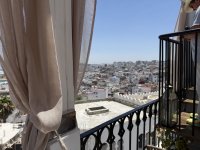

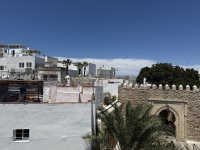


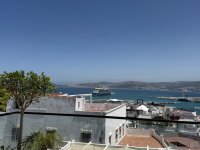



After a restful lunch, we continued our tour.
This door top has a Jewish star atop it. This was done so the neighbors would know to not disturb the other neighbors during their sabbath or holidays time. It was common to share, spices, sugar, flour and oils and this way you’d know when or when not you could ask your neighbor without inconveniencing or disturbing them.

We’re now approaching the market, or shuk.
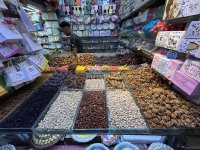


This scene was part of the Bond movie, Spectre. We had lunch at the restaurant (rooftop) right where the steps in Tangiers is in this scene.

The first 36 seconds is this court area off to the left. The background of that shot of the sea are the following pics.












After a restful lunch, we continued our tour.
This door top has a Jewish star atop it. This was done so the neighbors would know to not disturb the other neighbors during their sabbath or holidays time. It was common to share, spices, sugar, flour and oils and this way you’d know when or when not you could ask your neighbor without inconveniencing or disturbing them.

We’re now approaching the market, or shuk.


Brett-EDH
TVWBB Olympian
Next we were on to some of the rich Jewish history of Tangier. Jews had lived in this are for over 3,000 years, many arriving after the destruction of the first temple.
Here’s a link worth reading as it will give more contextual background than I can.
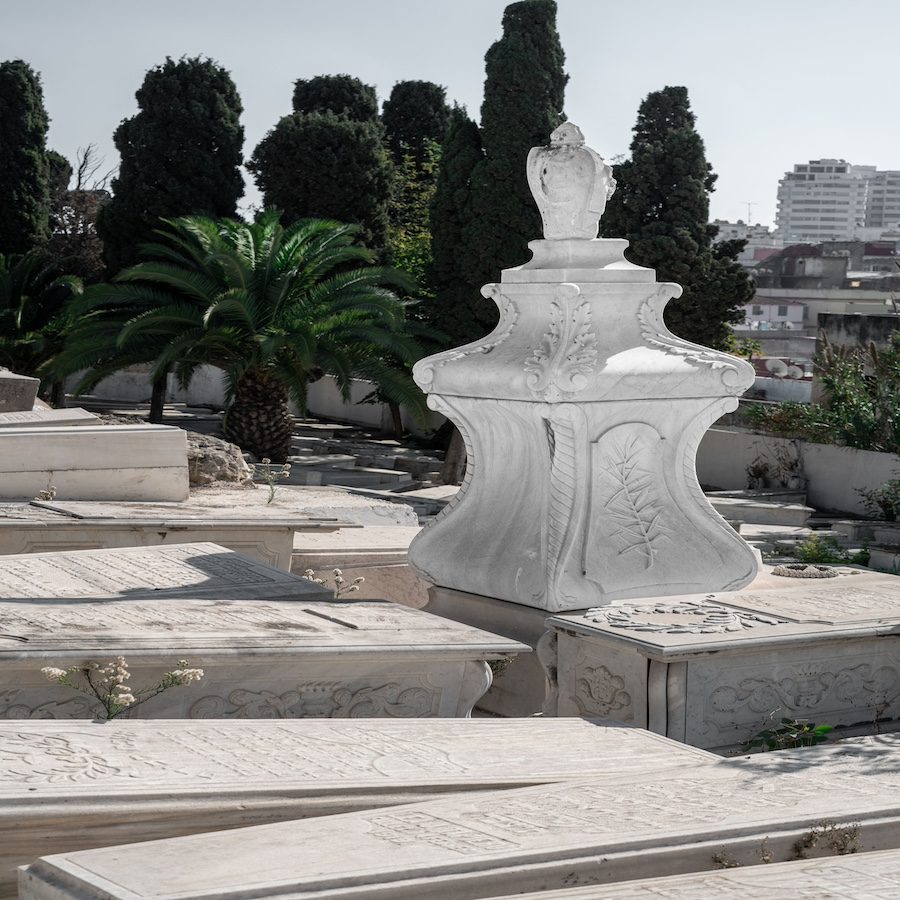
We first happened upon the old Jewish cemetery. There are grave stones dating back to the 16th century here. Unfortunately, the gates were locked. I really wanted to enter and say a prayer to those at rest there. Maybe another time.
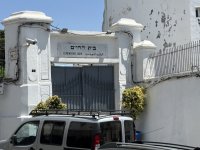
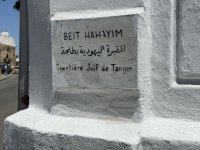

The cemetery it located right outside the city walls.

Synagogue Street. There used to be around 20 active synagogues in the city.

Today there’s around 100-150 Jews remaining in Tangier. The population was over 20,000 in its heyday. The city and country have had a substantial Jewish population decline decline for decades now. And for many reasons.

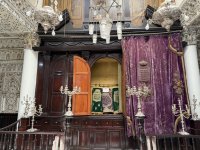
The detail work is incredible.

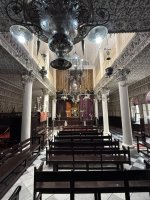
Next we met with the local oven baked. This community oven is over 150 years old. People would bring their items that needed baking to this below ground oven and a baker would cook your items. You’d pay him some money for his time and use of the oven. Boy,
have things changed over time, except for here.

This used to be a building by where people lived. With its open center court. The court has now been covered and the space is used as a restaurant.
You can really see the fine wood work, architecture and details.

Our day was just about done. We exited the old city. You can see the age of the city walls here.
It’s amazing that something so old is still in vibrant and vital use today. Very different than here in the USA. We tend to demolish buildings and start new.
It’s a pretty large contrast between living in the states and how those who do, live in Africa and Europe.

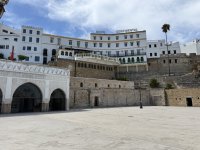
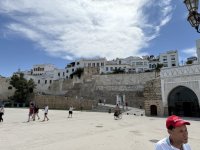



Next up? Any guesses?
Here’s a link worth reading as it will give more contextual background than I can.

Unveiling Tangier's Hidden Gems: Discovering the Jewish Heritage Sites - Morocco Travel Blog
Explore Tangier's Hidden Gems, a fusion of Moroccan, Spanish, Portuguese, and French influences. Uncover its rich Jewish heritage.
moroccotravelblog.com
We first happened upon the old Jewish cemetery. There are grave stones dating back to the 16th century here. Unfortunately, the gates were locked. I really wanted to enter and say a prayer to those at rest there. Maybe another time.



The cemetery it located right outside the city walls.

Synagogue Street. There used to be around 20 active synagogues in the city.

Today there’s around 100-150 Jews remaining in Tangier. The population was over 20,000 in its heyday. The city and country have had a substantial Jewish population decline decline for decades now. And for many reasons.


The detail work is incredible.


Next we met with the local oven baked. This community oven is over 150 years old. People would bring their items that needed baking to this below ground oven and a baker would cook your items. You’d pay him some money for his time and use of the oven. Boy,
have things changed over time, except for here.

This used to be a building by where people lived. With its open center court. The court has now been covered and the space is used as a restaurant.
You can really see the fine wood work, architecture and details.

Our day was just about done. We exited the old city. You can see the age of the city walls here.
It’s amazing that something so old is still in vibrant and vital use today. Very different than here in the USA. We tend to demolish buildings and start new.
It’s a pretty large contrast between living in the states and how those who do, live in Africa and Europe.






Next up? Any guesses?
Brett-EDH
TVWBB Olympian
Oh, you just wait. There’s more coming. And the best will be near the end.Amazing photos
Brett-EDH
TVWBB Olympian
Malaga, Spain
Next, we headed to Malaga, Spain for a tapas and walking tour.
We were quite surprised by Malaga. We didn’t really have any expectations but Malaga over delivered.

With a population just shy of 600k people, Malaga is the 6th largest city in Spain and she’s filled with classic Roman and Arabic architectural influences as having been occupied by both peoples in her time over 2,800 years.
There’s a mix of wide boulevards and traditional narrow streets that barely a car can drive down now.
Some guy named Pablo Diego José Francisco de Paula Juan Nepomuceno María de los Remedios Cipriano de la Santísima Trinidad Ruiz y Picasso was born in Malaga. You might have heard of him.
The main shopping district has this aerial canopy covering the street/walkway. Very smart and innovative as it makes shopping there more appealing in the summer heat and sun.

We started our food tour, led by Fernando (
)
We started in the local market, and this place did NOT disappoint! Some of the best food we had in all of Spain.

 maps.app.goo.gl
maps.app.goo.gl


We started with fried anchovies. OMG!

These were lightly dusted in flour and then flash fried. If you like anchovies, nothing beats anchovies from the Mediterranean Sea. Small, packed with flavor and not salty at all. Lots of umami and amazing flavor.
Next we had aubergines (eggplant) in matchsticks, lightly flour dusted, quickly fried and served with molasses.
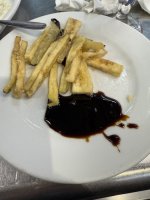
Next we enjoyed some pimientos de padron. These are not spicy green peppers pan fried in olive oil. Great flavor. And often served with entrecôte (seared thin rib eye, which I ate a bunch of in Spain and France).

I forgot the grab a pic of our drink, summer wine.
It’s a red wine served on tap, mixed with sparkling lemonade and a twist of orange slice over one large cube of ice. It was refreshing and very tasty. I had two of those by noon. Feeling good for sure. The Spanish know how to start the day.
Some more pics of the market. It was full of fresh meats, fish, olives, fruits, veggies and assorted pastries and meat pies. I could really enjoy a market like this in life. It’s a shame we don’t have anything like this here in California or the states.




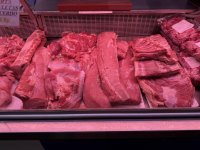

Sampling some roasted pork shoulder on baugette. Yes, it was excellent.

The gambas were beautiful!

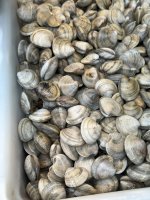
Fresh cut ahi

Squid

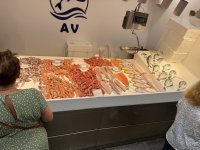

Next, we headed to Malaga, Spain for a tapas and walking tour.
We were quite surprised by Malaga. We didn’t really have any expectations but Malaga over delivered.

With a population just shy of 600k people, Malaga is the 6th largest city in Spain and she’s filled with classic Roman and Arabic architectural influences as having been occupied by both peoples in her time over 2,800 years.
There’s a mix of wide boulevards and traditional narrow streets that barely a car can drive down now.
Some guy named Pablo Diego José Francisco de Paula Juan Nepomuceno María de los Remedios Cipriano de la Santísima Trinidad Ruiz y Picasso was born in Malaga. You might have heard of him.
The main shopping district has this aerial canopy covering the street/walkway. Very smart and innovative as it makes shopping there more appealing in the summer heat and sun.

We started our food tour, led by Fernando (
We started in the local market, and this place did NOT disappoint! Some of the best food we had in all of Spain.
Mercado de Atarazanas · 4.6★(44416) · Market
C. Atarazanas, 10, Distrito Centro, 29005 Málaga, Spain
 maps.app.goo.gl
maps.app.goo.gl


We started with fried anchovies. OMG!

These were lightly dusted in flour and then flash fried. If you like anchovies, nothing beats anchovies from the Mediterranean Sea. Small, packed with flavor and not salty at all. Lots of umami and amazing flavor.
Next we had aubergines (eggplant) in matchsticks, lightly flour dusted, quickly fried and served with molasses.

Next we enjoyed some pimientos de padron. These are not spicy green peppers pan fried in olive oil. Great flavor. And often served with entrecôte (seared thin rib eye, which I ate a bunch of in Spain and France).

I forgot the grab a pic of our drink, summer wine.
It’s a red wine served on tap, mixed with sparkling lemonade and a twist of orange slice over one large cube of ice. It was refreshing and very tasty. I had two of those by noon. Feeling good for sure. The Spanish know how to start the day.
Some more pics of the market. It was full of fresh meats, fish, olives, fruits, veggies and assorted pastries and meat pies. I could really enjoy a market like this in life. It’s a shame we don’t have anything like this here in California or the states.






Sampling some roasted pork shoulder on baugette. Yes, it was excellent.

The gambas were beautiful!


Fresh cut ahi

Squid



Brett-EDH
TVWBB Olympian
We continued in the market making our way to another section.
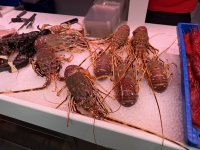






Next we headed to a charcuterie tasting along with some vermouth. I can report that I am now a fan of vermouth over a rock for summer enjoyment.

I really musta been a little loaded as I forgot to grab pics of our final tapas location for the day.
We enjoyed a jamon (Iberico belotta) croquet along with a fish and potato soup. Not a chowder. Super unique to Malaga.
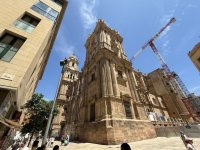
 malagacatedral.com
malagacatedral.com

Overall, this was a great day. We have Malaga on our list to visit again.
With its placement on the Mediterranean Sea, there’s lots to do and of course eat some of the best seafood around.








Next we headed to a charcuterie tasting along with some vermouth. I can report that I am now a fan of vermouth over a rock for summer enjoyment.

I really musta been a little loaded as I forgot to grab pics of our final tapas location for the day.
We enjoyed a jamon (Iberico belotta) croquet along with a fish and potato soup. Not a chowder. Super unique to Malaga.
- Gazpachuelo: This soup from Malaga traditionally includes mayonnaise, fish, fish stock, and potatoes, giving it a distinctive creamy and white appearance. It's a popular choice during winter.

Inicio
Últimas noticias VER TODAS MISA ESTACIONAL 28 de agosto de 2023 Noticias | Editar 8 septiembre, 2023 Misa estacional: Santa Iglesia Catedral Basílica de Málaga a las 11:30 h. Procesión: […]
 malagacatedral.com
malagacatedral.com

Overall, this was a great day. We have Malaga on our list to visit again.
With its placement on the Mediterranean Sea, there’s lots to do and of course eat some of the best seafood around.




